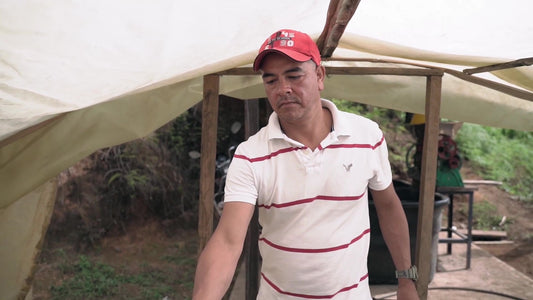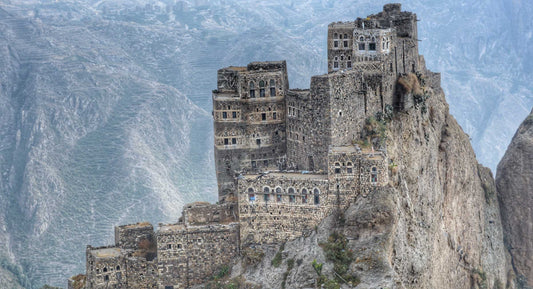At Firebird Coffee Company, we are deeply committed to sourcing coffee from farmers impacted by conflict and helping them secure a livelihood by exporting their coffee to specialty roasters in Europe. One of our most treasured offerings is the Mocha Mills Harazi Wadi Alma coffee. This post delves into the rich history of Yemeni coffee, the impact of ongoing conflicts on its production, the effect of the Red Sea crisis on coffee supply chains, and how specialty coffee can transform lives positively. By exploring these aspects, we aim to shed light on why Yemeni coffee is so special and why it deserves our support.
The Rich History of Yemeni Coffee
Origins of Yemeni Coffee
Yemeni coffee boasts a history that stretches back over 550 years. The practice of cultivating, roasting, and drinking coffee began in Yemen around 1450. It was here that Sufi monks first discovered that they could roast the raw, green seed of the Coffea arabica plant, blacken it with heat, and brew an invigorating beverage. This beverage helped them stay awake and alert during their nightly studies and prayers.
Although the coffee plant itself is most likely native to Ethiopia or Sudan, the art of cultivating and brewing coffee is a Yemeni invention. From 1450 to 1650, coffee culture spread from Yemen to cities such as Mecca, Cairo, Damascus, and Istanbul. However, it wasn’t until 1650 that coffee made its way to Europe, where it quickly became all the rage. Thousands of coffee houses opened in cities like London, Paris, and Vienna, and coffee from Yemen's port city of Al Mokha (Mocha) was in high demand.
Spread of Coffee Culture
The global spread of coffee from Yemen is a fascinating tale of trade and cultural exchange. The word "mocha" became synonymous with coffee for the next 250 years, thanks to the high-quality beans exported from Yemen. These beans fuelled the burgeoning coffee culture in Europe, where coffee houses became centres of social and intellectual life. Notably, Lloyd’s of London, one of the world’s leading insurance markets, was founded in one such coffee house.
Yemen’s coffee cultivation monopoly lasted until 1726 when Java began producing coffee. The Dutch, who controlled Java, exported large quantities of coffee to Europe, ending Yemen’s dominance. Despite this, Yemen remained an important coffee-producing region, known for its unique and high-quality beans.
The Unique Characteristics of Yemeni Coffee

Growing Regions and Varietals
Yemeni coffee is grown in mountainous areas at high altitudes, between 1600 and 2100 meters above sea level. The unique geographical and climatic conditions in these regions contribute significantly to the distinctive flavors of Yemeni coffee. Let's explore some of the prominent coffee-growing regions in Yemen and their unique characteristics.
Bani Mater
Bani Mater is one of the most renowned coffee-growing regions in Yemen. Located near the capital city of Sana’a, this region is characterized by its high altitude and fertile soil. Coffee from Bani Mater is known for its complex and aromatic profile, often featuring bright acidity and fruity notes. The coffee plants here benefit from the cool temperatures and ample rainfall, which contribute to the development of intricate Flavors.
Bani Hammad
Bani Hammad is another significant coffee-growing region, known for producing high-quality coffee with unique flavour profiles. The region’s high altitude and diverse microclimates create ideal conditions for coffee cultivation. Coffee from Bani Hammad is often noted for its rich body, vibrant acidity, and hints of floral and fruity notes. The traditional farming practices and careful processing methods in this region ensure the production of exceptional coffee beans.
Bura’a
Bura’a, located in the western part of Yemen, is a region with a long history of coffee cultivation. The high-altitude terraces in Bura’a are well-suited for growing coffee, and the beans produced here are known for their distinctive Flavors. Coffee from Bura’a often exhibits a balanced profile with a combination of sweetness, acidity, and complex aromas. The unique terroir of Bura’a, coupled with the traditional cultivation methods, contributes to the exceptional quality of coffee from this region.
Haraaz
The Harazi region, where Mocha Mills Harazi Wadi Alma coffee is produced, is celebrated for its unique growing conditions and high-quality beans. This region is known for its diverse microclimates, fertile soil, and traditional farming practices. The Jaadi varietal, grown in Haraaz, is renowned for its exceptional flavour profile, which includes notes of mango, red wine, clove, tamarind, and dark chocolate. The anaerobic natural process used to produce this coffee enhances its unique characteristics, resulting in a cup that is both vibrant and nuanced.
Haimateen
Haimateen is another prominent coffee-growing region in Yemen, known for its high-altitude terraces and fertile soil. Coffee from Haimateen is characterized by its rich body, balanced acidity, and complex flavour profile. The beans produced in this region often exhibit notes of fruit, chocolate, and spices, making them highly sought after by specialty coffee enthusiasts. The traditional farming practices and careful processing methods in Haimateen contribute to the exceptional quality of its coffee.
The Impact of Conflict on Yemeni Coffee Production
Historical Context of Yemeni Conflicts
Yemen has been embroiled in conflict for many years, with the most recent civil war beginning in 2014. This ongoing conflict has had a devastating impact on the country’s economy, infrastructure, and agricultural practices. Coffee farmers have faced significant challenges, including displacement, limited access to markets, and a lack of resources.
The civil war has exacerbated Yemen’s already difficult conditions. The country has become deeply water-impoverished, and a large percentage of available water is used to cultivate qat, a plant with narcotic properties. This shift in agriculture has further reduced the land and resources available for coffee farming.
A Brief Overview of the Yemen Conflict
The Yemen conflict, often described as one of the world's worst humanitarian crises, has its roots in the complex political, social, and economic landscape of the country. The civil war, which began in 2014, has caused immense suffering and disruption to millions of Yemenis, significantly impacting all aspects of life, including coffee production.
Origins of the Conflict
The Yemen conflict traces back to longstanding grievances and power struggles within the country. Yemen, historically divided into North and South Yemen, was unified in 1990. However, tensions remained between various factions, including the Northern and Southern regions, tribal groups, and political entities. The current conflict escalated in September 2014 when Houthi rebels, a Shia-led movement from the northern region of Saada, seized the capital city of Sana'a.
The Houthis, who had been engaged in on-and-off conflict with the Yemeni government for years, took advantage of widespread dissatisfaction with the government of President Abdrabbuh Mansur Hadi. The rebels demanded lower fuel prices and a new government, leading to their takeover of Sana'a and subsequent control over large parts of the country.
International Involvement
The conflict took on an international dimension in March 2015 when a coalition of Gulf states, led by Saudi Arabia, launched a military intervention in support of the Hadi government. This coalition, which included the United Arab Emirates, Egypt, and other regional powers, aimed to restore the internationally recognized government and push back the Houthi rebels. The intervention received logistical and intelligence support from western countries, further complicating the conflict.
Iran, a regional rival of Saudi Arabia, has been accused of supporting the Houthis, turning the Yemen conflict into a proxy war between the two Middle Eastern powerhouses. This international involvement has exacerbated the conflict, leading to a prolonged and devastating war with significant civilian casualties.
Humanitarian Crisis
The ongoing conflict has had catastrophic consequences for Yemen's population. The United Nations has described Yemen as the largest humanitarian crisis in the world, with over 24 million people, approximately 80% of the population, in need of humanitarian assistance. The war has led to widespread food insecurity, with millions facing famine-like conditions. Additionally, the conflict has caused severe shortages of clean water, healthcare, and basic services, further exacerbating the humanitarian situation.
The blockade imposed by the Saudi-led coalition has restricted the flow of goods, including essential food and medical supplies, into Yemen. This has contributed to soaring inflation and a collapsing economy, making it even more difficult for Yemenis to access basic necessities.
Who are the Houthis?
The Houthis, officially known as Ansar Allah (Supporters of God), are a political and armed movement originating from Yemen's northern region of Saada. This Shia-led group has played a central role in Yemen's ongoing conflict and has become a significant force in the country's political landscape. Understanding the Houthis' origins, ideology, and role in the Yemen conflict is crucial to grasping the complexities of the war.
Origins and Ideology
The Houthi movement traces its roots back to the early 1990s when it emerged as a Zaydi Shia revivalist group in the Saada governorate of northern Yemen. The Zaydis, a branch of Shia Islam, have historically held significant influence in Yemen, with Zaydi imams ruling parts of the country for nearly a thousand years until the 1962 republican revolution.
The movement was initially founded by Hussein Badreddin al-Houthi, a member of Yemen's Zaydi Shia minority, who advocated for the revival of Zaydi traditions and opposition to foreign interference, particularly from Saudi Arabia and the United States. The group's ideology blends religious, political, and social elements, emphasizing the preservation of Zaydi identity, resistance against perceived external domination, and addressing socio-economic grievances.
Rise to Prominence
The Houthis first gained significant attention in the early 2000s through a series of insurgencies against the Yemeni government, led by President Ali Abdullah Saleh at the time. These conflicts, often referred to as the Saada Wars, were driven by the Houthis' opposition to Saleh's government, which they accused of corruption, neglecting the northern regions, and aligning too closely with Saudi and U.S. interests.
Hussein al-Houthi was killed by Yemeni government forces in 2004, and leadership of the movement passed to his brother, Abdul-Malik al-Houthi. Under Abdul-Malik's leadership, the Houthis became more organized and expanded their influence, gradually gaining control over larger territories in northern Yemen.
Role in the Yemen Conflict
The Houthis' role in Yemen's ongoing civil war began to escalate in 2014 when they took advantage of widespread dissatisfaction with the transitional government led by President Abdrabbuh Mansur Hadi. Capitalizing on economic woes, political instability, and public discontent, the Houthis captured the capital city of Sana'a in September 2014, forcing Hadi to flee to the southern city of Aden and eventually to Saudi Arabia.
In March 2015, a coalition of Arab states led by Saudi Arabia launched a military intervention in Yemen, aiming to restore Hadi's government and push back the Houthi rebels. The intervention received logistical and intelligence support from the United States and other Western countries. The Houthis, in turn, have been accused of receiving support from Iran, making the conflict a proxy war between regional powers.
Houthi Governance and Control
Since capturing Sana'a, the Houthis have established control over significant portions of Yemen, including the capital and other major cities. They have set up their own administrative structures and governing bodies, often operating parallel to or in place of the internationally recognized government.
The Houthi governance style has been characterized by both attempts to provide public services and reports of heavy-handed repression. The group has sought to maintain order and offer basic services in areas under its control, but it has also been accused of human rights abuses, including arbitrary detentions, forced disappearances, and restrictions on freedom of expression.
Impact on Yemen's Humanitarian Crisis
The Houthi takeover and subsequent conflict have significantly exacerbated Yemen's humanitarian crisis. The Saudi-led blockade, aimed at restricting the flow of arms to the Houthis, has also limited the import of essential goods, including food, medicine, and fuel. This blockade, combined with ongoing fighting, has led to widespread food insecurity, a collapsing healthcare system, and severe shortages of basic necessities.
The Houthis have also been accused of contributing to the crisis through their actions, including the use of landmines, sieges of cities, and the conscription of child soldiers. The conflict has displaced millions of Yemenis, and the United Nations has described Yemen as the world's worst humanitarian disaster, with over 24 million people in need of assistance.
The Houthis are a complex and influential force in Yemen's ongoing conflict. Their rise from a regional insurgency to a dominant political and military power reflects the deep-rooted issues within Yemen, including historical grievances, socio-economic disparities, and the influence of regional and international actors. Understanding the Houthis' role and motivations is essential to comprehending the broader dynamics of the Yemen conflict and the challenges of achieving lasting peace in the region.
Challenges Faced by Yemeni Coffee Farmers
Yemeni coffee farmers face numerous challenges due to the ongoing conflict. The conflict has severely disrupted Yemen's agricultural sector, including coffee production. Farmers face significant challenges, such as displacement, lack of access to markets, and limited resources. The destruction of infrastructure, such as roads and water systems, has made it difficult to transport coffee to market and maintain traditional farming practices. Economic hardships have made it difficult for farmers to invest in their land and practices. Infrastructure, such as roads and water systems, has been damaged or neglected, making it challenging to transport coffee to market.

Additionally, the conflict has disrupted traditional farming practices and limited access to international markets. Exporting coffee from Yemen is fraught with difficulties, including political conflicts and governmental obstacles. These challenges drive up the cost of green coffee, making it less competitive on the global market.
The Impact of the Red Sea Crisis on Coffee Supply Chains
Red Sea Crisis Overview
The Red Sea crisis, exacerbated by escalating political tensions in the Middle East, has significant implications for global trade, including the coffee supply chain. Recent attacks on commercial vessels transiting the Red Sea have disrupted key shipping routes, leading to delays and increased costs. This crisis stems from Israel's ongoing war in Gaza, which has led the Houthis, a political and military organization in Yemen, to attack commercial shipping vessels traveling through the Red Sea.
Impact on Coffee Supply Chains and Prices
The disruption of shipping routes through the Red Sea has had a profound impact on the coffee supply chain. Many shipping companies have halted or rerouted their vessels to avoid the conflict zone, leading to increased shipping times and costs. The Red Sea is one of the most important trade routes in the world, with approximately 12% of global trade passing through it, including a significant portion of global container traffic.
Why is Yemeni Coffee so expensive?
The increased shipping times and costs have created bottlenecks in the coffee supply chain, leading to delays in the arrival of coffee shipments and higher prices for green coffee. The conflict has also resulted in higher insurance premiums for shipping companies, further driving up the cost of transporting coffee. These factors have combined to create a challenging environment for coffee exporters and importers, impacting the availability and affordability of coffee for consumers.
What is Qat?
Cultural Significance and Usage
Qat, also spelled khat, is a plant native to the Horn of Africa and the Arabian Peninsula, particularly Yemen. The leaves of the qat plant contain a stimulant called cathinone, which produces a mild euphoria and excitement similar to that conferred by strong coffee. Chewing qat leaves is a widespread cultural practice in Yemen and other parts of the region.
In Yemen, qat chewing is deeply ingrained in the social fabric. It is a common activity during social gatherings, business meetings, and even family events. Men, women, and even some children participate in qat chewing sessions, which can last for several hours. The leaves are typically chewed slowly and stored in the cheek, where the stimulant is absorbed through the mucous membranes.
Hallucinogenic Effects
Qat has mild hallucinogenic effects due to the presence of cathinone, a naturally occurring stimulant. Chewing qat leaves produces a sense of euphoria, increased alertness, and enhanced sociability. Users often experience a sense of well-being and heightened energy levels. However, excessive use can lead to insomnia, increased heart rate, and digestive problems.
Environmental and Social Impact in Yemen
The widespread cultivation of qat in Yemen has significant environmental and social impacts. One of the most pressing issues is the consumption of water resources. Yemen is one of the most water-scarce countries in the world, and a large percentage of its available water is used for irrigating qat crops. This has led to severe water shortages for other essential agricultural activities, including food and coffee production.
The dominance of qat cultivation also has economic implications. Many farmers in Yemen prefer to grow qat because it is a lucrative cash crop with a ready market. However, this shift away from food and coffee production has contributed to food insecurity and reduced the land available for cultivating other crops. Additionally, the social impact of qat chewing includes reduced productivity and potential health risks associated with long-term use.
The Positive Impact of Specialty Coffee on Yemeni Farmers
Economic Empowerment
Specialty coffee has the potential to transform the lives of Yemeni coffee farmers by providing them with a stable source of income. Companies like Mocha Mill are working closely with farmers to improve their agricultural practices and increase the quality and yield of their coffee crops. By offering fair prices and providing support in the form of training and resources, these initiatives are helping farmers achieve economic stability.

The establishment of Coffee Collection Centers (CCC) and state-of-the-art processing mills has also played a crucial role in empowering Yemeni farmers. These centres provide farmers with a centralized location to sell their coffee cherries, ensuring that they receive fair compensation for their produce. By reducing the reliance on middlemen and improving the traceability of coffee, these initiatives are helping to create a more transparent and equitable coffee supply chain.
Social Impact
Specialty coffee initiatives in Yemen are not only improving the economic prospects of farmers but also having a positive social impact. A significant focus is placed on empowering women, who make up approximately 75% of the coffee farmers in Yemen. By providing training and support, these programs are helping women gain financial independence and improve their livelihoods.

Additionally, the emphasis on sustainability and innovative agricultural practices is helping to address some of the environmental challenges faced by Yemeni farmers. By implementing water-saving techniques and promoting organic farming methods, these initiatives are contributing to the long-term sustainability of coffee production in Yemen.
Firebird Coffee Company’s Commitment to Yemeni Coffee
Supporting Conflict-Affected Farmers
At Firebird Coffee Company, we are dedicated to supporting farmers who are impacted by conflict. By sourcing coffee from regions like Yemen, we are helping to provide a stable source of income for farmers who face significant challenges. Our collaboration with Mocha Mill and other partners in Yemen allows us to offer high-quality specialty coffee while making a positive impact on the lives of farmers.
Promoting Sustainability
Sustainability is at the core of our business practices. We are committed to implementing innovative irrigation and dry processing techniques to address water scarcity and reduce the environmental impact of coffee production. By promoting sustainable farming practices, we aim to ensure the long-term viability of coffee farming in Yemen and other conflict-affected regions.

Ensuring Quality and Transparency
We believe in maintaining the highest standards of quality and transparency in our coffee supply chain. By working closely with our partners and farmers, we ensure that our coffee is traceable and meets the highest quality control standards. Our commitment to transparency extends to our customers, who can trust that they are supporting ethical and sustainable coffee production when they choose Firebird Coffee.

Yemeni coffee is a testament to resilience and excellence. Despite the challenges posed by ongoing conflicts, water scarcity, and the dominance of qat cultivation, Yemeni coffee farmers continue to produce some of the world’s finest coffee. By supporting specialty coffee initiatives and promoting sustainable practices, we can help these farmers achieve economic stability and improve their livelihoods.
At Firebird Coffee Company, we are proud to offer Mocha Mills Harazi Wadi Alma coffee, a shining example of the exceptional quality and unique flavours of Yemeni coffee. By choosing Yemeni coffee, you are not only enjoying a remarkable beverage but also making a positive impact on the lives of farmers and their communities. Together, we can help restore Yemen’s rich coffee heritage and ensure a brighter future for its coffee farmers.




